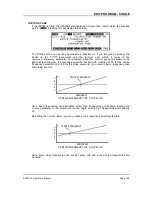
SAMPLE
S3000XL Operator’s Manual
Page 121
When you have entered a unique name, you will see * NEW * appear next to the sample
name indicating that the name you have entered is unique:
If * NEW * does not appear, then a sample of the same name already exists in memory.
TIP 1: It is worth taking the time to name your samples sensibly. It may be quick to simply
call them SAMPLE 1, SAMPLE 2, 3, 4, etc., but, when you come to put them into a
program, these names may not mean much to you. If you return to them in a week they
certainly won’t! Names like PIANO C#3 are best - this tells you the instrument and the
note it is sampled on so it will be easier to set your program up later when you come to
assign your samples to specific keyranges.
TIP 2: If you are about to make a lot of recordings of a similar type, put the note number
first (i.e. C#3 PIANO, E 3 PIANO, G 3 PIANO, etc.). In this way, you don’t have to cursor
through the whole name to give the sample its unique note identifier.
Once you have named the sample, you are now ready to make a new recording. First,
however, let’s have a quick look at the parameters on this page.
You may select to record in MONO or STER(eo). When you opt to record
in stereo, two samples will be created and -L and -R will be appended to
each of them to indicate the left and right sample.
This sets the note on which the new sample will be placed when you
record it. The default is C 3 but you may set any note you like. You will
note that you can set the note by specifically moving the cursor to this field
and using the DATA wheel or you may set it by playing the note on your
MIDI controller (i.e. keyboard).
NOTE: To set the note from a MIDI controller, you must be monitoring the input signal (i.e.
F7 should be showing
) and, of course, the controller should be on the same MIDI
channel as the S3000XL.
This sets the length of time you will record for.
The page also shows what percentage of memory is free, the current sample rate (44100)
and the size (expressed as a percentage of available memory) of the sample you are
about to make.















































